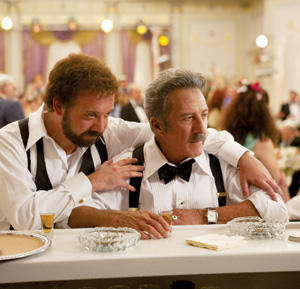

CHECKING Mordecai Richler’s 1997 novel Barney’s Version after seeing the new film adaptation, I realized that it wasn’t the usual case of the movie ruining the book but of the book sort of ruining the movie.
Reading the Richler and liking it fine, I was disappointed that director Richard J. Lewis’ version of Barney’s Version skews melodramatic and inappropriately touching. Worthwhile as the film is, it robs us of some of the salt and acid of Richler’s last novel: an oddly sprightly and profane payback.
Taking the novel aside, though, Lewis’ comedy is an unusually intelligent and sarcastic film. It has scope, taking place over the course of decades roughly between the 1950s and the 1990s. It exalts, and wraps in some pricey lingerie, the surprising beauty of Rosamund Pike, as well as the extremely different, and yet equally surprising beauty of Minnie Driver. Jewish-Canadian Princess turns out to be a great look for this Irish woman, go figure. In some satin underclothes during a ghastly Roman honeymoon, Driver does a robust burlesque of Sophia Loren’s similar negligee parts in the early 1960s.
Back in the real world of runty, coarse men, Dustin Hoffman gets some of his own back after the sweat-soaked dad role he endured in Little Fockers. He sports an RAF mustache and perhaps a dental prosthetic, a bit of a Terry Thomas gap to his teeth. Hoffman is a treat tearing up a pretentious Jewish wedding with a wealth of unspeakable stories.
As his son, a chip off the block, Paul Giamatti is the Barney in question, a harried but wealthy Montreal TV producer, a veteran of a long life in a land where anti-Semitism wells up from time to time. Barney is also notorious as the prime suspect in the murder of his drug-wracked buddy Boogie (Scott Speedman, looking like a low-cal substitute for Matthew McConaughey), whose body was never found. Boogie’s dramatic purpose is obvious: you can hold any kind of discursive, frolicking narrative together as long as you assure the reader there’s a dead body coming up.
Barney’s three marriages were catastrophes of different varieties. He first married an insane artist (Rachelle Lefevre), then a raving materialist (Driver) and then finally Miriam (Pike), a woman way too good for him. He fiendishly fell in love with his third wife-to-be during the course of his second wedding.
As Miriam, Pike is ravishing, and it’s easy to believe her as a radio personality; the Shakespearean training shows in the music of her voice. But if Miriam seems underwritten—a too-poised, studio-movie figure—blame Richler. It’s hard to believe in Miriam clinging to a single youthful principle, particularly when principles tend to soften in older age.
As this artist of the perfect squelch, Giamatti is bracingly cast, and one can’t imagine anyone else in the part. Barney is similar to Miles in Sideways, with quantities of desperation and porcine wrath. But Barney is a little dirtier, a born troublemaker, more sinning than sinning against. This character is just plain too much for some viewers, a big bite of horseradish for the shrinking palate.
The film version has a “seriously folks” ending in which Barney is redeemed through shame and physical suffering. I’d rather not specify the suffering, on the grounds that anyone ordering huge portions of smoked meat sandwiches, Montecristos and single malt is going to pay the Grim Waiter at some point.
And the murder is clumsily solved through a TV newscast. The book had it perfect. There, the mystery of Boogie was resolved in an instant; it was like Alec Guinness’ fateful blink at the end of Kind Hearts and Coronets, where he realizes that the hangman’s got him, even though he’s temporarily escaped the noose. Barney, an intellectual who likes to pose as a vulgarian, would recognize Pascal’s idea of life as a comedy with a bloody finish. The way Lewis films this, it’s a comedy with a bloody awful finish.
R; 132 min.



